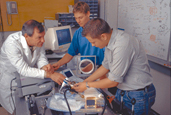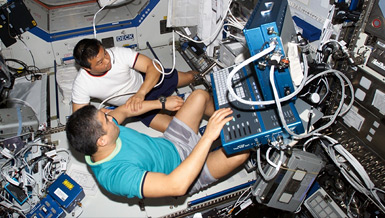Dr. Lawrence Crum and his colleagues are continuing the development of a portable, lightweight, ultrasound-based device that would be used to detect and treat various medical conditions during long-duration spaceflights. The device will not require the user to have high skill levels. The therapeutic ultrasound device will have capabilities such as detecting and treating internal bleeding, performing bloodless removal of tumors, and effectively reducing kidney stones to a safe size.
Overview

Left: "Twinkling" image of a kidney stone. Twinkling results from using Doppler Ultrasound to image a stone rather than the normal grey scale ultrasound. Right: Twinkling probably results from the complex scattering that results when a Doppler pulse scatters from a stone, as shown in this modeling image. The researchers are studying ways to use diagnostic ultrasound for early detection of kidney stones in astronauts. Images courtesy of University of Washington. Click here for larger image.
Smart Therapeutic Ultrasound Device for Mission-Critical Medical Care

A portable, ultrasound device is being developed that could one day be used to find and treat ailments using noninvasive surgical treatments. The device generates heat inside the body with pinpoint accuracy to stop bleeding or kill unwanted tissue such as tumors. Photo by Kathy Sauber. Click here for larger image.
Principal Investigator:
Lawrence A. Crum, Ph.D.
Organization:
University of Washington
Technical Summary
3. Lack of noninvasive diagnostic imaging capabilities.
Specific Aims
2. Develop methods and technologies that would enable detection of renal stones with ultrasound.
3. Develop technology and perform in vitro studies of stone comminution.
4. Utilize the technology and protocols developed in Aims 2 and 3, to perform in vivo studies in a porcine model.
2. Conducted in vitro and animal tests toward transcutaneous tumor ablation treatment with HIFU. Completing initial investigation of HIFU-induced, tumor-specific immune response in collaboration with The Fred Hutchinson Cancer Research Institute and initiated a second animal study with Seattle Cancer Care Alliance on the clinical HIFU system created by the company Philips Medical. Characterized the acoustic output and optimized exposure parameters of the Philips machine. Efforts are underway for commercially-sponsored clinical trials for pancreatic cancer. Developing modeling and characterization tools, testing ultrasound guidance, replicating acoustic output with smaller instrumentation and initiating additional research. Papers published and others are pending approval by commercial collaborators.
3. Developed new method to emulsify tissue with transcutaneous ultrasound. Our method has several potential advantages over the technique used in competitor's 11 million dollar start-up. Our method also has promise as a potential surgical tool. Submitted provisional patent and published papers.
4. Developed second prototype to detect and reposition kidney stones with ultrasound. This is a proposed new treatment for early detection of stones in microgravity as well as for reposition of the stones near the exit of the kidney for natural clearance. It also has significant Earthbound clinical and commercialization potential. Human studies of the detection algorithm have begun and approval in principle for treatment in human subjects has been granted, pending final acoustic output measurements. Safety and efficacy have been demonstrated in pigs. An intellectual-property package has been prepared by the University of Washington (UW) for potential licensing. A business/commercialization plan has been developed. A commercial partner has been identified and initial investigation into the regulatory and reimbursement pathways has taken place. This information was shared with NASA to identify the next ultrasound system for the International Space Station (ISS) as our capabilities to address gaps could be integrated directly into certain existing ultrasound systems.
5. A miniaturized device to size stone fragments for safe extraction has been tested in a porcine kidney. Submitted U.S. utility patent application and published paper. This topic has been the subject of licensing negotiations between the UW and a potential commercial sponsor.
We licensed revolutionary diagnostic ultrasound hardware from an original equipment manufacturer and added a few changes of our own. With NSBRI’s help, we made the case that if similar hardware were selected as the ultrasound system on ISS, our capability to detect and treat stones could be immediately deployed for emergency treatment of urolithiasis.
To summarize, in our acoustic hemostasis effort, we have results ready to publish, expect to continue our substantial DARPA-funded effort working toward human subjects testing, and will utilize our NSBRI-developed systems in animal studies. On our HIFU ablation studies, animal experiments should soon be completed and published this year, and all pieces should be in place to initiate human studies. On stone disease, our device is expected to be tested on human subjects. A new transducer will be developed and acoustic output characterization for regulatory approval will begin. We plan to transfer some of this technology to a new start-up.
Earth Applications
More invasive procedures are often necessary if the stone is in the lower pole because, even if fragmented, the pieces are unlikely to pass from this location. Our technology might keep the least invasive option open for these patients. In most existing procedures, there is a significant chance stone pieces will remain behind as seeds for future stones and further surgery. Our technology could help these pieces pass.
In addition, stones are often recurrent; recurring-stone patients are often monitored, so that new stones can be detected early. This monitoring could be done in astronauts with our precise stone-imaging approach. Our technology could also move these stones to the kidney exit before they are symptomatic. This technology reduces risk of surgery, complications of surgery for the patient and the cost of surgery to the insurance companies. Furthermore, the technology does not preclude any surgical options. Lastly, the algorithms to detect kidney stones alone stand to spare many patients the ionizing radiation of a computed tomography (CT) scan or provide options to pregnant women or children with stones who are unlikely to receive a CT scan.
NSBRI quickly recognized the value of this technology and helps us initiate our commercialization effort that now has the full support of The University of Washington, the Washington Research Foundation, a commercial hardware provider as well as the interest of several venture capitalists and ultrasound companies.
The applications of our technology to the control of bleeding and for tumor ablation are at least as profound. Specifically, this year we have worked with the latest clinical high-intensity focused ultrasound (HIFU) machine which was developed by Philips Medical. This machine is intended for many clinical applications. We have used some of our effort to characterize the output of the machine and assess its potential bio-effects. Our work provides the clinicians who intend to use this machine the ability to select a thermal dose. At the University of Washington alone, it helps train the clinicians and establish the specificity of what size targets are treated. With our contribution, the clinicians are then likely to pursue their own clinical studies and with Philips Medical backing regulatory approval for various tumor treatments. Before our involvement, the machine sat dormant for a year. We are also exploring the effect of HIFU on the immune system and have proposed clinical trials to combine HIFU with chemotherapy agents. We believe that our efforts to carefully describe outputs and bio-effects will help the U.S. catch up with the rest of the world where over 400,000 patients have been treated by HIFU. In addition, our intimate knowledge of these details enable us to consider ways in which a similar, much reduced-in-size, system could be developed for NASA to reduce some major risks to astronauts.
The control of bleeding with ultrasound has great potential to save lives from both civilian and battlefield trauma. Our most directed work leverages Defense Advanced Research Projects Agency-funding and is in partnership with a commercial entity. This ambitious project seeks to develop a fully autonomous system that would both detect bleeding and induce hemostasis without major user involvement.





